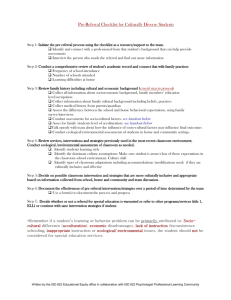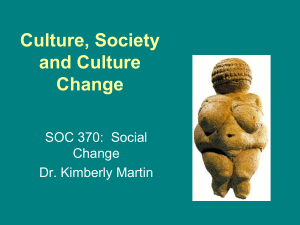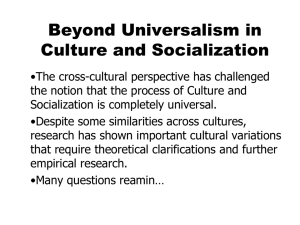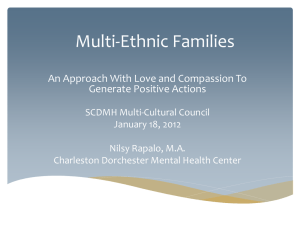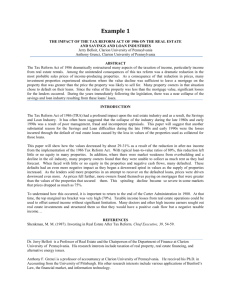The aim of this research is to examine the role of acculturation in the
advertisement
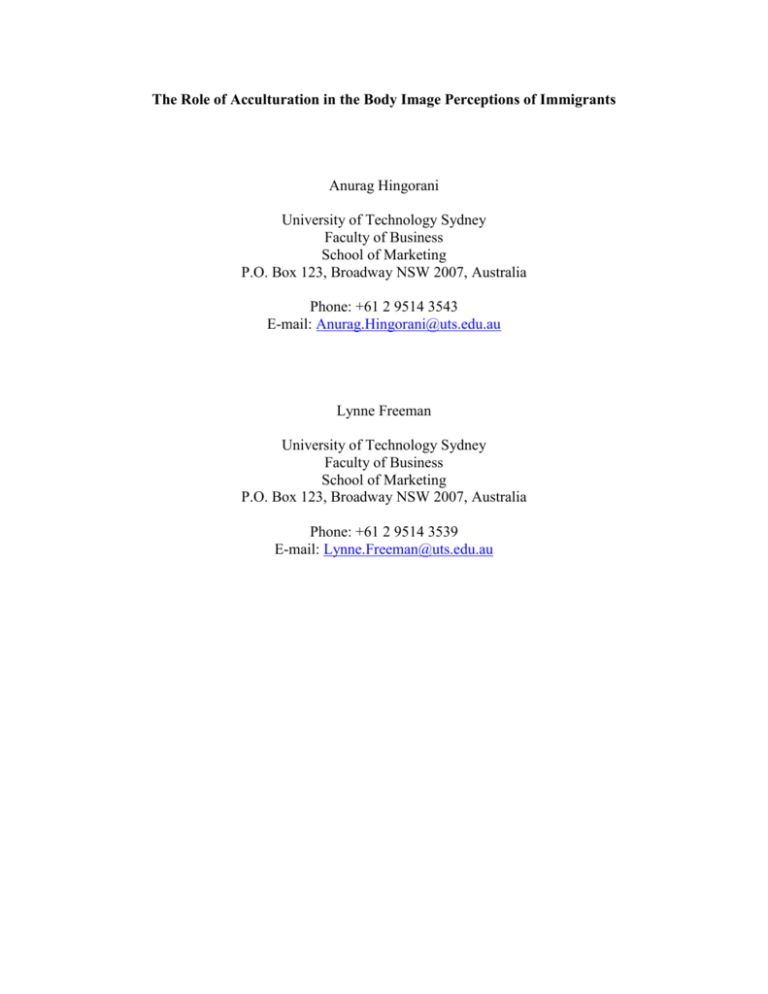
The Role of Acculturation in the Body Image Perceptions of Immigrants Anurag Hingorani University of Technology Sydney Faculty of Business School of Marketing P.O. Box 123, Broadway NSW 2007, Australia Phone: +61 2 9514 3543 E-mail: Anurag.Hingorani@uts.edu.au Lynne Freeman University of Technology Sydney Faculty of Business School of Marketing P.O. Box 123, Broadway NSW 2007, Australia Phone: +61 2 9514 3539 E-mail: Lynne.Freeman@uts.edu.au Abstract The aim of this research is to examine the role of acculturation in the body image perceptions of an immigrant community in Australia, namely, Indian-Australians. Acculturation is the process of change an individual experiences moving cultures, during which values, attitudes and societal standards of the new culture can be adopted. Body image is a multidimensional construct characterized by perceptions of, attitudes toward, and values about the body. This research builds on existing cross-cultural, body image research by applying a qualitatively assessed and multi-dimensionally constructed perspective of acculturation and utilizing avatars (i.e., digital visual representations of the ‘self’) to understand perceptions. Extended Abstract Body image has been investigated for centuries, however, theorists and practitioners alike are yet to achieve a complete understanding of this complex and multi-dimensional construct. Particularly over the past 50 years, body image research has proliferated in divergent areas of research (Cash 2004) ranging from the social sciences to medical sciences. One of the major areas has been in the area of cross-cultural studies, and the impact ethnicity has upon the development of body image perceptions (e.g., Abrams and Stormer 2002; McCabe, Ricciardelli, Mellor, and Ball 2005; Ogden and Elder 1998; Pompper and Koenig 2004; Sheffield, Tse, and Sofronoff 2005; Tiggemann and Ruutel 2001). These studies attempted to investigate ethnic variations of the body image construct by comparing and contrasting a Western culture against an ethnic culture. However, many of these studies involved ethnic participants who either reside in a Western country or have had significant exposure to Western values and attitudes. They have failed to take into consideration the possible influence of exposure to, and/or adoption of, Western values and attitudes on their participants’ body image perceptions (e.g., Altabe 1998; Goodman 2002; Ogden and Elder 1998; Pompper and Koenig 2004; Sheffield et al. 2005). Soh, Touyz, and Surgenor (2006) believe that the results of these studies are limited as the role or influence of acculturation to the Western society was not considered. In this research, body image has been defined as a “multidimensional construct characterized by perceptions of, attitudes toward, and values about the body” (Cash 2004, 216). Acculturation is defined as the process of change an individual experiences moving cultures (Berry 1990). Values, attitudes and societal standards are adopted within this process, which in many cases may result in a change of an individual’s ethnic identity (Berry 1990). Soh et al. (2006, 55) suggest that the study of the impact that acculturation has on body image will provide a way forward in “teasing out” the relationship between body image concerns and culture. Body image studies that have attempted to investigate the impact of acculturation (e.g., Ball and Kenardy 2002; Soh et al. 2006) have largely conceptualised it uni-dimensionally and measured it quantitatively. They have assessed the extent or degree of acculturation using proxy measures such as generational status (first-generation or second-generation). In order to achieve a contextual and multi-dimensional understanding of the acculturation experience, Cabassa (2003) believes that existing quantitative measures should be complemented with a qualitative methodology. This will produce a richer picture of what particular areas of a person’s life, including body image perceptions, change, when living in a new culture. Building on our previous research (Agudera, Freeman, and Hingorani 2007), this research project aims to extend body image research, which so far has predominantly assessed acculturation uni-dimensionally and quantitatively, by utilizing qualitative methods to examine the acculturation experience as a multi-dimensional construct, and avatars, i.e., digital visual representations of the ‘self”, to understand body image perceptions. Specifically, this research has the following objectives: 1. To understand the impact of socio-cultural influences of media, peers and family, on an individual’s perceptions of body image. 2. To investigate generational differences in body image perceptions. 3. To identify any ethnic variations in body image perceptions across two cultures. 4. To investigate the factors that shape the acculturation experience and the impact they have on an individual’s body image perceptions. A qualitative focus group study was conducted to allow for a contextual and holistic investigation of the relationship between the two complex constructs of body image and acculturation. Discussions in focus groups were guided by the research objectives and centered on perceptions of ‘ideal self’, ‘actual self’, and a ‘typical Australian’. Leadingedge technology was developed to allow focus group participants to first individually create avatars and then interpret them for the group. Generally speaking, avatar-creation is tantamount to a visual projective technique. The creation of avatars facilitated clearer articulation and discussion about body image issues, which might otherwise be unclear or incomplete, given the reliance on participants’ drawing skills, and ability to communicate visually using traditional paper-and-pencil methods. Prior research has demonstrated the effectiveness of visual projective techniques to understand body image issues in a multicultural context (Haward 1955; Hayslip Jr., Cooper, Dougherty, and Cook 1997). Most research on body image issues has focused on women, as does this research. However, to date, there has been little research on body image in the Indian-Australian community, which is growing rapidly (ABS, Australian Social Trends 2003). Hence, this particular immigrant community was selected. Specifically, the focus group sample consisted of females with Anglo and Indian heritages in an Australian context, and from two generations, namely, Generation Y (aged 20-25 years, approximately) and Baby Boomers (aged 43-55 years, approximately). Generational status is a common proxy variable for assessing acculturation in quantitative research. It is employed under the premise that later generations experience acculturation at a much faster rate, whilst first-generation immigrants tend to maintain and hold fervently on to their ethnic values and attitudes. First-generation immigrants are those born overseas, second-generation immigrants are those who were born in the host country but their parents were born overseas and third- or greater generation immigrants are those who were born in the host country along with their parents (Valentine 2001). To gain a deeper understanding of the acculturation process, generational status was employed qualitatively by exploring the manner in which first- and second-generation immigrants have experienced acculturation and investigating the extent to which the adoption of Australian attitudes and values has affected the development of body image perceptions across two generations. Therefore, one of the Indian-Australian focus groups consisted of first-generation immigrants, and the other, second-generation immigrants. By examining two different generations of Indian-Australians, it is likely that some of the differences in body image perceptions might be due to external influences, which are not acculturation-related. To ensure that acculturation-related differences in the Indian generations are clearly captured, inter-generational differences and similarities between Generation Y and Baby Boomer Anglo-Australian groups were studied as a “control”. Prior cross-generational body image research on Filipino- and Anglo-Australians (Agudera et al. 2007) that did not involve computer-generated avatars found similarities and differences between the various groups. For example, the older Anglo-Australian group felt that the younger generation have become more materialistic and more concerned with themselves but that they were just as concerned with their body image when they were their age. The older Filipino-Australian group believed that because they lived on the very basics in the Philippines and had less affordability and access to consumer items, they were less materialistic and concerned with appearance, fashion and body image than the younger generation. Findings similar to the Filipino research are expected in this research on IndianAustralians when the data are completely analyzed. However, what has been determined via observation is that unlike the Filipino research, the use of cutting-edge technology to create avatars enabled participants in this research to more completely communicate their perceptions, and focus on issues surrounding body image. References Abrams, Laura and Colleen Stormer (2002), “Sociocultural Variations in the Body Image Perceptions of Urban Adolescent Females,” Journal of Youth and Adolescence, 31(6), 443-450. Agudera, Michelle, Lynne Freeman, and Anurag Hingorani (2007), “Body Image and the Effect of the Acculturation Experience: A Filipino Perspective within an Australian Context,” unpublished thesis of the first author. Altabe, Madeline (1998), “Ethnicity and Body Image: Quantitative and Qualitative Analysis,” International Journal of Eating Disorders, 23(2), 153-159. Australian Bureau of Statistics (ABS) (2003), Australian Social Trends 2003 (updated 20 April 2006). Ball, Kylie and Justin Kenardy (2002), “Body weight, body image, and eating behaviours: Relationships with ethnicity and acculturation in a community sample of young Australian women,” Eating Behaviors, 3, 205-216. Berry, John (1990), “Psychology of Acculturation,” Cross-Cultural Perspectives: Nebraska Symposium on Motivation, Vol. 37, ed. J. Berman, Lincoln, NE: University of Nebraska Press, 201-234. Cabassa, Leopoldo (2003), “Measuring Acculturation: Where We Are and Where We Need to Go,” Hispanic Journal of Behavioral Sciences, 25(2), 127-146. Cash, Thomas (2004), “Body Image: past, present and future,” Body Image, 1(1), 1-5. Goodman, Robyn (2002), “Flabless is Fabulous: How Latina and Anglo Women Read and Incorporate the Excessively Thin Body Ideal into Everyday Experience,” Journalism and Mass Communication Quarterly, 79(3), 712-727. Haward, L.R.C. (1955), “Some Inter Cultural Differences on the Draw-a-Man Test: Part III, Conclusion,” MAN, 55, 40-42. Hayslip Jr., Bert, Caren Cooper, Linda Dougherty, and Diane Cook (1997), “Body Image in Adulthood: A Projective Approach,” Journal of Personality Assessment, 68(3), 628-649. McCabe, Marita, Lina Ricciardelli, David Mellor, and Kylie Ball (2005), “Media Influences on Body Image and Disordered Eating Among Indigenous Adolescent Australians,” Adolescence, 40(157), 115-127. Ogden, Jane and Charlotte Elder (1998), “The Role of Family Status and Ethnic Group on Body Image and Eating Behavior,” International Journal of Eating Disorders, 23(3), 309-315. Pompper, Donnalyn and Jesica Koenig (2004), “Cross-Cultural-Generational Perceptions of Ideal Body Image: Hispanic Women and Magazine Standards,” Journalism and Mass Communication Quarterly, 81(1), 89-107. Sheffield, Jeanie, Kathryn Tse, and Kate Sofronoff (2005), “A Comparison of BodyImage Dissatisfaction and Eating Disturbance among Australian and Hong Kong Women,” European Eating Disorders Review, 13, 112-124. Soh, Nerissa, Stephen Touyz, and Lois Surgenor (2006), “Eating and Body Image Disturbances across Cultures: A Review,” European Eating Disorders Review, 14, 54-65. Tiggemann, Marika and Eha Ruutel (2001), “A Cross-Cultural Comparison of Body Dissatisfaction in Estonian and Australian Young Adults and its Relationship with Media Exposure,” Journal of Cross-Cultural Psychology, 32(6), 736-742. Valentine, Sean (2001), “Self-Esteem, Cultural Identity and Generational Status as Determinants of Hispanic Acculturation,” Hispanic Journal of Behavioral Sciences, 23(4), 459-468.


